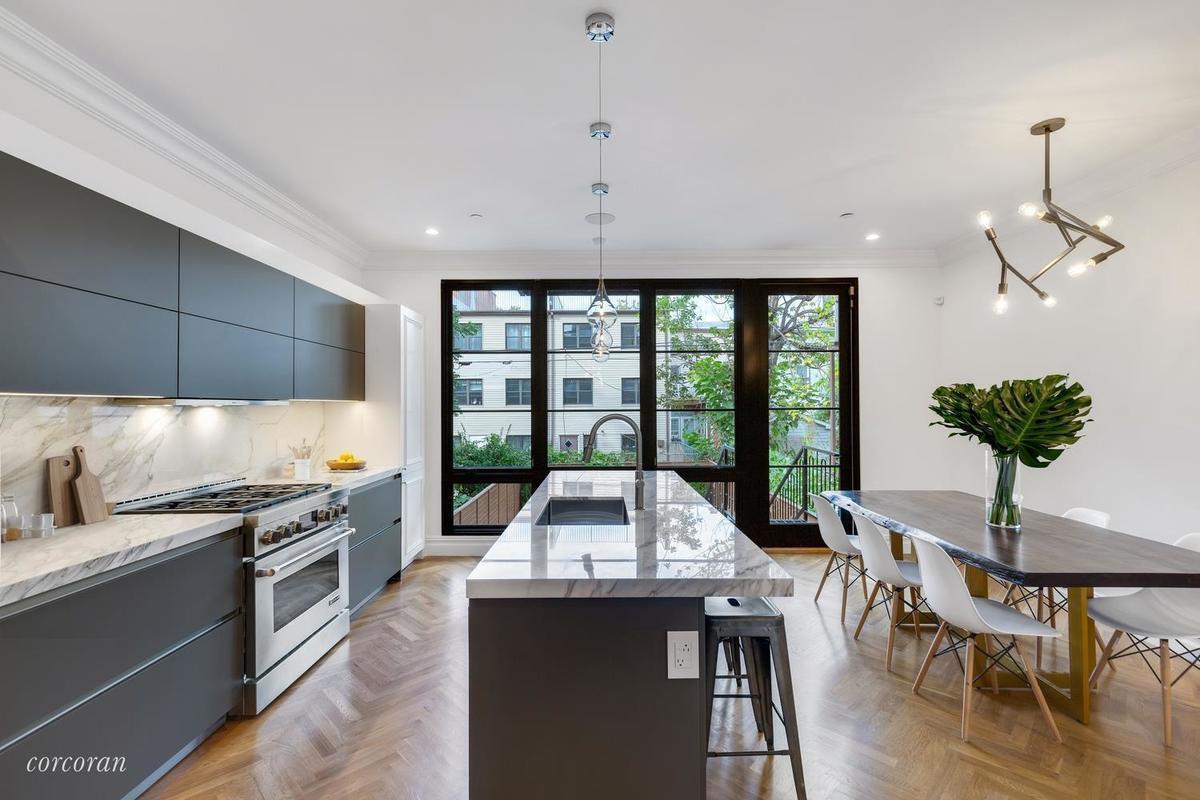
A renovated kitchen in a StreetEasy listing at 385 Gates Ave. in Brooklyn, represented by Daniel Kandinov at Corcoran.
In a StreetEasy survey, a majority of NYC homeowners (58%) admitted that their homes needed a little TLC, while another 18% said their places could use some serious updating [1].
So what’s the best course of action? If your home needs work, is it better to spend time and money renovating it, or simply move to a newer (or nicer) apartment? And how much would either option actually cost you?
To help answer these critical questions, we partnered with our friends at Sweeten, the free renovation matchmaking service, to dig into the data and uncover the true cost difference — in both time and money — between renovating and moving. It turns out that while renovating is often cheaper and easier, whether it makes more sense than moving really depends on your needs and circumstances.
Growing Family or Big Refresh?
Buying a new home while simultaneously selling your current place may sound like a daunting task, and it’s important to know that the costs and fees involved can quickly add up. Between the basic home prep costs, agent commissions, transfer taxes, move-in fees, attorney fees, etc., New Yorkers will spend an average of $60,000 to relocate.
Surprisingly though, moving can still net out to be less expensive than a full apartment renovation. In fact, moving homes, even in a city as expensive as New York, is nearly $18,000 cheaper than a full apartment renovation [2].However, while moving may be cheaper, a renovation is often faster. Plus it will allow you to get exactly what you want out of your existing home — from the custom cabinets you’ve been dreaming of in the kitchen to the exact tile flooring you envision in the bathroom.
According to data from Sweeten, a full-apartment renovation typically takes up to four months (excluding the time to obtain permits and approvals), while a move typically takes roughly five months from the start of the search to moving day.
But maybe you love your apartment overall, and just struggle with your kitchen. In that case, a smaller room makeover can be much more cost-effective and quicker than moving. Or, say your family is growing, and a nursery becomes a necessity. Getting creative with your existing layout and adding a wall to create a separate space for your newborn is eight times more affordable than relocating to a new home.
Use the chart below to uncover the average cost and length of the most common home renovations in New York City, and compare them to what’s involved in selling your current home and moving into a new one.
Moving Costs the Most in Manhattan, Renovating Is Priciest In Brooklyn
It’s widely known that Manhattan has the highest home prices in New York City, with a median of $1.1 million, nearly 40% higher than the $820,000 median sales price in Brooklyn.
When it comes to home renovations, a different trend emerges. According to Sweeten, the median cost of a Brooklyn kitchen makeover is nearly 8% higher than in Manhattan, at $42,944 and $39,821, respectively. With bathroom updates, the story is the same — the median cost in Brooklyn is $26,473, some 7.5% higher than Manhattan’s $24,635.
This difference arises because Brooklyn apartments typically have larger kitchens and bathrooms than Manhattan ones, and in the business of renovations, more space equals higher cost. That said, when looking at the cost per square foot, Manhattan becomes the most expensive borough in the city in which to renovate.
Weighing the Trade-offs of Renovating Versus Moving
Ultimately, the choice to renovate or move is extremely personal, and comes down to what will work best for each homeowner’s individual situation and lifestyle.
Before making that decision, think about your current space. Is it workable for your present life stage? How does it compare to similar homes on the market? Have you lived there long enough to amass substantial equity, or do you have funds to put toward the purchase of another home? (A buyer’s agent can help you figure this out.)
The renovated master bath at 385 Gates Ave.
How much control do you want over the details of your space? How much do you love your neighbors and your neighborhood? Are you able to find temporary space while you renovate your current home?
If you choose to renovate, regardless of when you’re planning to ultimately sell your home, it’s wise to renovate the areas that will have the most impact in the market. In general, smaller, less expensive upgrades like new windows or a bathroom remodel can often bring a bigger reward than more involved and time-consuming ones. You can make your home work for your current lifestyle while increasing its attractiveness to potential buyers.
Whatever option you choose, make sure to prioritize for the long term, and assemble an all-star team of local professionals. Your dream home awaits.
[1] According to a representative StreetEasy survey of current NYC homeowners who did not move in the past 12 months. The survey was fielded online in summer 2018 in partnership with independent market research firm YouGov. Quotas based on the U.S. Census were set for age, gender, and education. The data was then weighted to known U.S. Census estimates on age, gender, race and education, to ensure that respondents were representative of the New York City population. Input was also taken from estimates compiled on StreetEasy’s blog.
[2] Sources: Zillow® and Thumbtack’s 2019 Hidden Costs of Selling analysis reveals New York metro-area sellers spend $33,510 on average to sell their homes between basic home prep and closing costs. Also, assuming closing costs for buyers come out to 4% of the sale price, the median closing cost for New Yorkers in the first quarter of 2019 would be $25,960.
—
Inspired to find your next place in New York? Whether you’re looking to rent or to buy, search NYC apartments on StreetEasy.